Are these Channels “DEAD?”
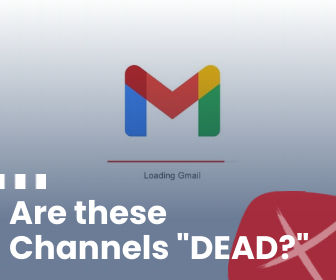
It seems like soooooo many articles/emails/ebooks/Facebook videos are titled something along the lines of: “blank” is dead. Or “Why the new ios update is going to kill email marketing.” Or “3 stats that prove print and mail is dead.” But it is? For the most part those titles are just clickbait, and the content just proves how it is very much not dead.
So, let’s take the three most common “dead” or “dying” marketing channels and see how effective they really are.
Email Marketing
I probably get an email once a week proclaiming the end of email marketing. How can email marketing be “dead?” Statista estimates that close to 320 BILLON emails will be sent every day in 2021. On average, office workers receive 127 every day. And a Forbes article from last year suggested that “every person needs at least four email accounts” for security reasons. However, quantity of emails is one reason some say that email marketing is losing its effectiveness as a marketing channel. Is that true?
Email is often one of the main touch points a brand has with a consumer and many younger consumers prefer to communicate with brands with email. Even email that’s clearly from a mailing list still feels like a direct conversation. Which contributes to email’s engagement rates. Across industry’s email average click-through-rate is 3.71 and the average open rate is 22.9. Although that may not seem like a lot, Facebook, Instagram, and twitters combined average engagement is only 0.58.
Part of the reason email gets better engagement rates is because with email, the message is directly reaching who it’s intended for.
Print and Mail
The death of print and mail has been predicted since the beginning of email. Probably even before then. One of the very first articles in our Weekly Vibe newsletter was called “Print’s Not Dead, Right?” It wasn’t in March 2020, and it defiantly isn’t now.
Direct mail average open rate is somewhere between 68 and 90%, which is double, triple, or quadruple the average open rates of other marketing channels. Do people who open direct mail actually purchase? Yes! On average people who receive direct mail purchase 28% more items and spend 28% more money!
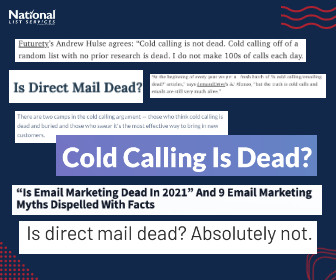
Why is direct mail so effective? It comes down to fact that we (humans) like getting mail. 41% of Americans of all ages look forward to getting their mail every day. We still want very real things in our hands, which is something totally lost in email inboxes or on social media. That tactile connection translates into 💰.
Cold Calling
Cold calling is another one of those things that’s been “on its way out” for years! Why is sticking around? At this point, an actual person to person conversation is a novelty and stands out against digital interactions. And sales, more than anything, based on connections and communications. It’s a lot easier to ignore an email than a ringing phone. It can also be harder to say no to a real person who you can actually hear.
If you add cold calling as part of your omnichannel marketing, work on your pitch, and be prepared to fail, you may be surprised at how effective it is!
What is your favorite marketing channel or tactic that’s been “dead” for years?
4 Internet Marketing Terms You Are Probably Using Wrong
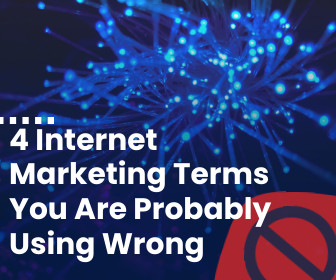
The internet and the marketing industry have something in common: They are full of terms and acronyms that can feel like an entirely different language. It can be super easy to misunderstand and/or misuse those terms. Here’s 4 “marketing/internet jargon” terms you are probably using wrong!
- Viral ≠ more views than you normally get
- Meme ≠ a picture with words on it. Please stop doing this
- Clickbait ≠ a catchy title
- Landing page ≠ a web page you’ve landed on
What do these words actually mean and how can you use them to communicate more effectively what you actually mean?
#1 Viral
What does it mean when you go viral? What makes something viral can be hard to quantify. There’s no magic number that means something is quote-on-quote viral. (Although MANY people try to make one.) Instead of defining viral by the numbers, it’s easier to quantify it by 2 things: reach and speed. The Wikipedia article on viral internet content makes the analogy that viral content is very similar to a virus. Viral internet content self-replicates and quickly spreads far from its original source. And often when content goes viral, it takes on its own life separate from what it was originally intended to be.
Let’s say one of your posts gets double or trip the amount of reach it normally gets. Is that viral? That’s very exciting, but no. Sorry! Although it’s possible to have something go viral with a specific community, viral implies exposure far outside it’s intended audience’s reach. With the number of platforms, and the cross-contaminating reach of those platforms, the general rule of thumb is over 2 million views in less than a few days to call something “viral.” This doesn’t mean that the content has to be a week old, it has to do with rate of expansion.
#2 Meme

This is one of my biggest pet peeves. It can be easy to look at a meme and think that any picture with words on it can be called a meme. It can be, but that doesn’t mean that it is. Meme was coined in 1976 by Richard Dawkins in his book on Darwinian evolution as an attempt to explain memetics; or, how ideas replicate, mutate, and evolve. What makes something a meme is not what it is, but instead the way that it replicates.
For example, the Star Wars “For the better, right?” meme has been a common format to use this month. What has made it a meme isn’t the original movie quote, or the format itself. It is a meme because many people are using or repurposing the format to convey information. Memes are only effective if the format conveys emotion or a message without it being explicitly stated and in a variety of different situations.

Although the types of memes we think of are usually in a concise image-based format, things like folk tales, urban legends, and chain letters are all versions’ memes. They are structured format in which information is shared and evolves.
#3 Clickbait
Are all catchy titles or hooks clickbait? No. The technical definition of clickbait is any text that is designed to entice a user to click or read on. However, the expression has a more specific connotation than that. It implies that the title isn’t accurate and is somehow disconnected from what you will see if you click. It’s similar to old school bait-and-switch marketing. Using bait or a hook isn’t wrong if you are looking to attract people, HOWEVER, the switch is wrong.
Clickbait is sensationalized content. An article titled “5 money making secrets you need to hear,” isn’t click bait if the article is actually about 5 money making tips. Which is part of what makes cracking down on malicious clickbait tricky. A lot of platforms like Facebook and YouTube measures in place to mark clickbait as spam. But how can AI decide if those 5 money making secrets are tips and tricks you actually need to hear? How does the platform know if those “secrets” can actually make you money? Clickbait is connected to consumer perception.
#4 Landing Page
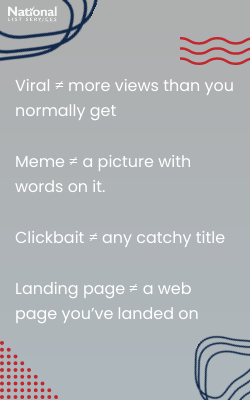
If you land on a webpage does that make it a landing page? No, because a landing page is a webpage you land on that is designed with a specific purpose in mind. One person illustrated it this way: You could use a baseball glove to retrieve a hot dish from the oven, but that doesn’t make your baseball glove an oven mitt. So just because someone lands somewhere doesn’t mean that it is a post-click landing page. The landing page could be designed get the user to make a purchase or fill out a form or watch a video. It doesn’t matter what the purpose is, it matters that it has one.
What is the advantage of separating your landing pages out to specify a single action? Research has shown that companies using 40 or more single action post-click landing pages generate 120% more leads than those using less than 5!
Do you have any marketing/internet terms misuse pet peeves?
5 Ways to Help Emails Reach People
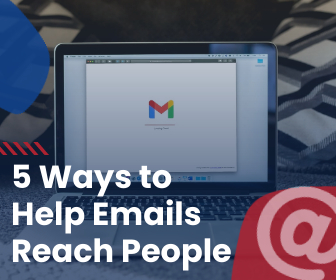
There are so many things that impact an email’s effectiveness. Often, what matters to the consumer and what matters to the email service are very different things. It’s important to strike the right balance in making the consumer and email service happy, as well as reaching your goal in sending the email. So, how can you make sure your emails reach people?
The Email Services
What do email services care about? They care about the backend/behind the scenes stuff. Things like how heavy images are and the amount of content and the types of links. This is where general best email practices come into play.
It’s important to give consumers an opportunity to opt in (and out if they want) of your email campaigns. If you don’t give people a way to opt out, you are breaking federal email laws and get blacklisted or penalized. Give people the option of choosing what types and how much email content they want from you. Follow through on their requests promptly. Legally, you are required to honor their request within 10 business days. Honoring that request promptly will build on their opinion of your brand.
What other email practices are required by law? Don’t use misleading or inaccurate header information such as your “To,” “From,” and “Reply-To” information. You want people to know where the email is coming from and so does the email service provider. Consumers don’t want to get an email from someone they don’t trust, and the email service provider doesn’t want to deliver email like that.
Don’t mislabel the email. The CAN-SPAM act requires that email subject lines accurate reflect the content of the email. That includes ad information. Like most social medias, email is required to tell the consumer if it an #ad. However, there is a lot of leeway on this and how you choose to disclose this information is up to you.
Consumer’s Opinions
Now that you have followed all the email laws and best practices to get your email in your consumer’s mailbox, what else should you do? Well, consumers care about catchy subject lines, engaging and interactive content. Here’s 4 things that will impact your emails effectiveness from the consumer’s point of view:
Choice of Words
Email marketing provides freedom for trying out different types of copy until you find works best for your audience. Every audience is different so what content will be the most effective is also different. It is important to understand your demographics and who your audience is.
Personalized Content
Email is more than just delivered information. It’s a conversation between brand and consumer. Often it a brand’s only way to communicate with customers and can feel very one on one. The consumer feels like they know the brand like a person, so it makes sense if the brand communicates with the consumer as if the know them as well. They are simple things that make that conversation more memorable, for example, many brands use the customer’s name in emails.
Beyond that you can use audience segmentation to separate your audience into groups that share common characteristics like demographics and behavioral information. Using your audience segments to target your message to things that each group are actually invested in can greatly increase how personal your marketing will feel to the customer.
Brand Consistency
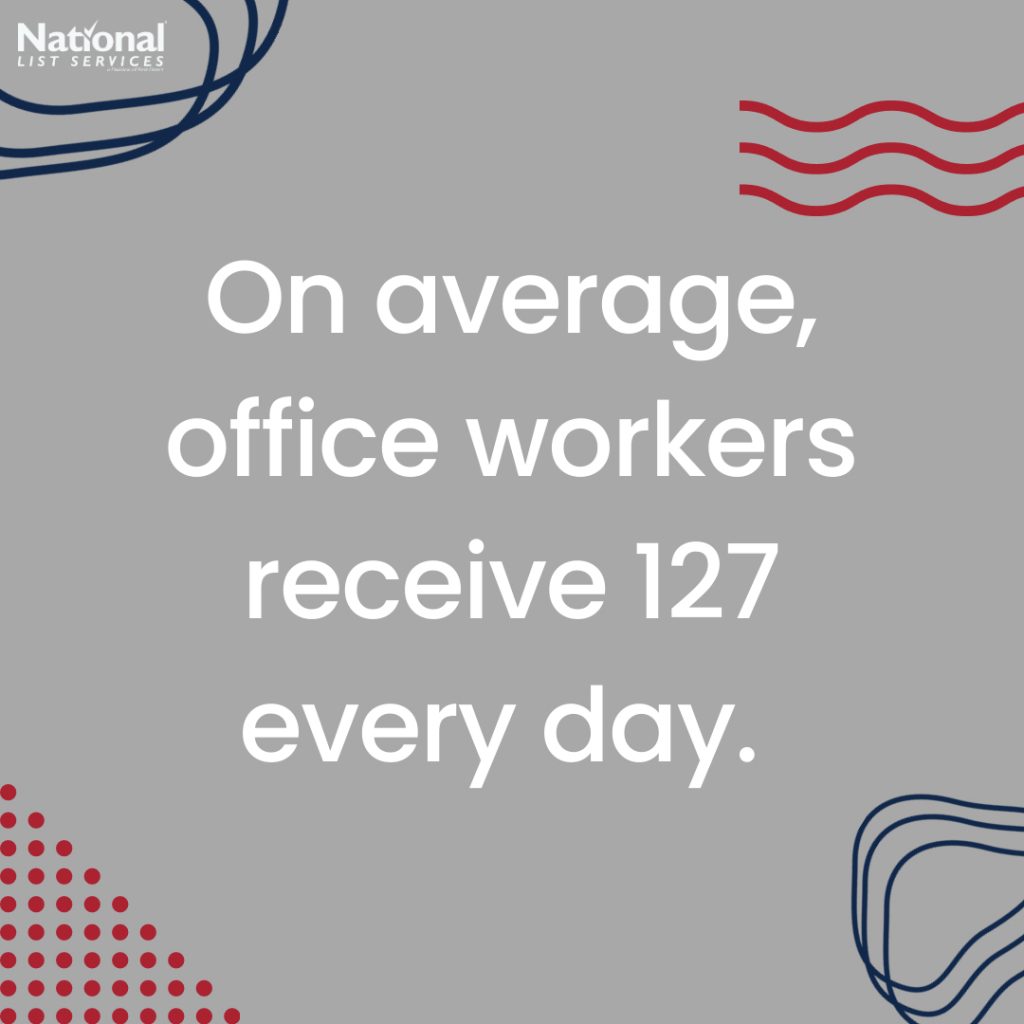
Since email is often one of main touch points brands have with consumers, it’s really important to maintain brand consistency. The consumer needs to know that the message is from you. Keeping that brand consistency helps your brand’s personality shine and helps people get to know you. Brand consistency builds loyalty and trust. It helps the consumer maintain the connection to your brand.
What brand elements should you include in your emails? Your logo, brand colors, and fonts are good places to start. Due to the nature of email, you don’t want to over crowd it with branding. Instead, think about how tone and feeling. Does the way this email is set up feel like how my brand feels?
Don’t waste people’s time
Most office workers receive 127 every day. People don’t have time to read lengthy emails that actually provide them value. Email copy writing is about providing value as succinctly and quickly as possible. Be direct and to the point. Don’t word vomit on people. Use infographics, bullet points, and short paragraph too highlight the point of your message.
What makes you open an email?
A Huge Mistake That Will Kill Your Profits Immediately
 At first everything was great. Tens of thousands of customers accept offers and cash in on coupons. The customer analytics data pouring in is an absolute gold mine.
At first everything was great. Tens of thousands of customers accept offers and cash in on coupons. The customer analytics data pouring in is an absolute gold mine.
Any company would love to have these solid, specific, fresh details: what offers people are actually responding to, when, what they’re buying, how they’re buying, what they’re ignoring and what they buy again.
But then the bottom dropped out…
The marketing director suddenly decided to ignore all this precious response data and go in a new direction. Months later? Sales are stagnant and everybody wonders what happened.
2017 was a bloodbath for companies making stupid mistakes like this. And sadly, the trend will continue. Why? It doesn’t have to happen, but people simply refuse to learn to market. “You’re selling from your heels,” the well paid expert explained to the nearly dead company. How does he explain the advice?
“It means you don’t 100% believe in what you’re doing.”
Despite all the hard work they put into marketing, tracking customer behavior, analyzing the data and sending out more offers… they threw it all in the trash.
Let’s say you have an employee. He’s a likeable and friendly salesman. But there’s a customer with deep pockets standing outside your door. And a whole week goes by. The customer still passes your door, pausing, waiting for an invitation to come in and buy. But your employee does nothing.
How long would you keep this employee?
Do you make this same blunder with your response data? It cost you real time, effort and money to execute marketing campaigns, track customer behavior and then store the data. Yet if you do nothing with it, this will cost you far more money than you ever spent to get the data.
In one study, 93% of businesses say data is important (or very important) to their success. Yet some companies lie to themselves: “Oh yes, we use our data.” But the truth is, they don’t send out any marketing until the next quarter. Data from the last quarter or last year?
It’s actually rotten by now. Unusable.
Nobody can deny it. Our business environment is changing so rapidly it takes real focus to keep up. It’s vital to know exactly who your target audience is… this month, this week, today. And it’s becoming essential for survival to use behavior data to narrow your focus down to who is going to buy right now.
Let’s say your analytics find 100,000 people who look just like your current customers. Yet predictive modeling shows that only 15,000 of these people will buy immediately. You’re smart. You don’t dismiss the other 85,000. You simply market to them differently than the 15,000.
You keep on digging. You find 5,000 among the 15,000 who become the prime focus of your marketing initiative. And you send out offers to them at least every month.
Companies who will dominate this year have a strategy and a plan that includes action like this. Are you starting to appreciate why it’s absolutely critical that you use really reliable data?
And then act on it?
The biggest mistake companies make is failure to take action. Enough action. Often enough. To grow their business and achieve the results, success and freedom they want.
Don’t make this mistake. Guard your data. Use your data. Refresh your data. Profit from your data.
Let’s make this year the best one yet.
| Click here to learn more |
